Holmes Institute HI5020: Corporate Accounting Cash Flow Report
VerifiedAdded on 2023/03/23
|20
|5886
|29
Report
AI Summary
This report provides a comprehensive analysis of cash flow and income statements within the context of corporate accounting. It begins by defining the content and significance of both statement types, emphasizing their importance for investors in assessing a company's financial health, liquidity, and profitability. The report then delves into a practical application, reviewing cash flow statements of three companies to analyze their major sources and uses of cash, trends in operational activities, capital expenditures, and dividends. The analysis includes assessing the companies' ability to generate cash from operations, cover capital expenditures and dividends, and manage working capital. Furthermore, the report evaluates the financial stability of the companies based on their cash flow statements and concludes with a recommendation for a potential lending scenario. The study incorporates relevant literature to support the analysis, providing a robust understanding of cash flow statements and their implications for business decisions.
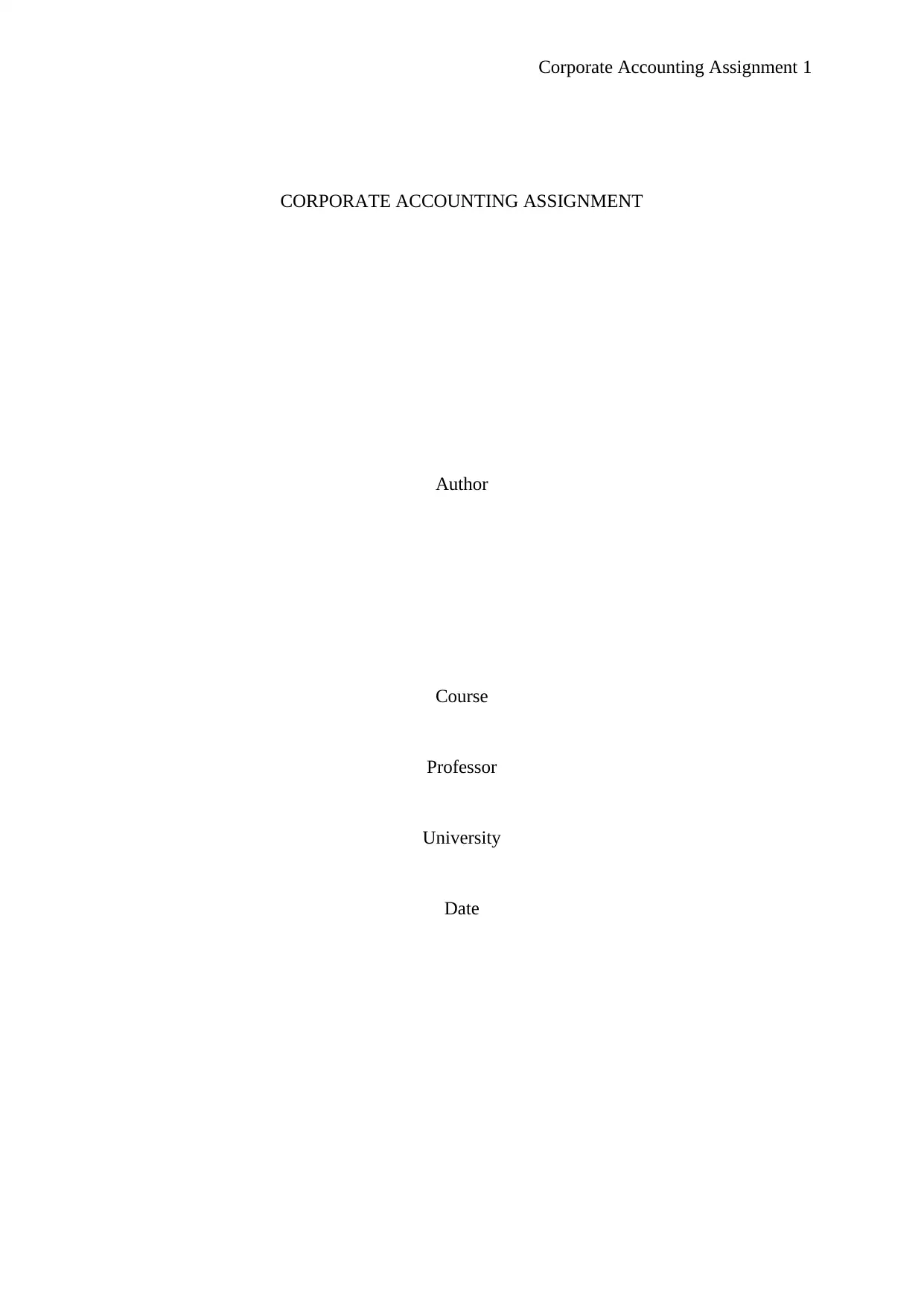
Corporate Accounting Assignment 1
CORPORATE ACCOUNTING ASSIGNMENT
Author
Course
Professor
University
Date
CORPORATE ACCOUNTING ASSIGNMENT
Author
Course
Professor
University
Date
Paraphrase This Document
Need a fresh take? Get an instant paraphrase of this document with our AI Paraphraser
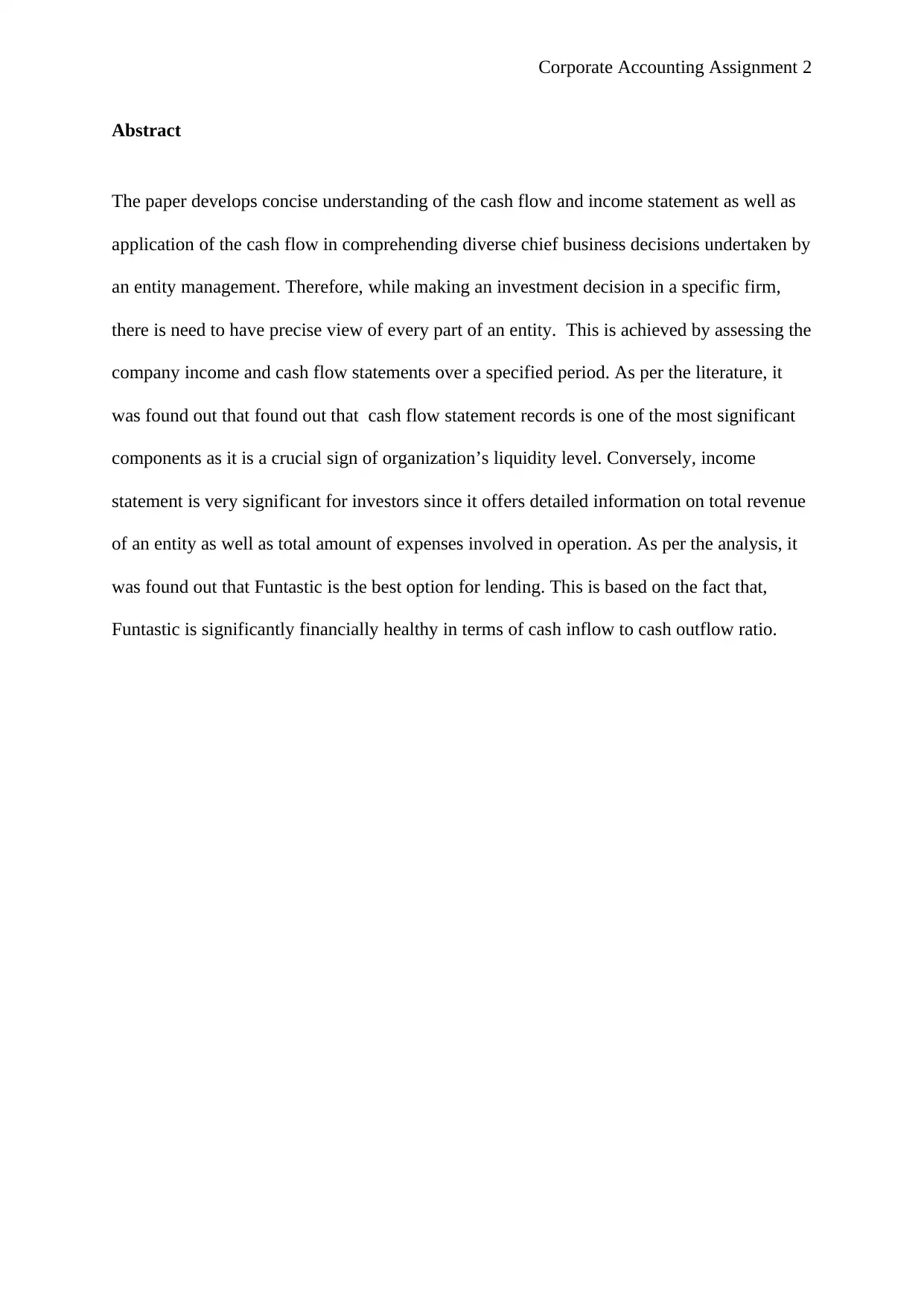
Corporate Accounting Assignment 2
Abstract
The paper develops concise understanding of the cash flow and income statement as well as
application of the cash flow in comprehending diverse chief business decisions undertaken by
an entity management. Therefore, while making an investment decision in a specific firm,
there is need to have precise view of every part of an entity. This is achieved by assessing the
company income and cash flow statements over a specified period. As per the literature, it
was found out that found out that cash flow statement records is one of the most significant
components as it is a crucial sign of organization’s liquidity level. Conversely, income
statement is very significant for investors since it offers detailed information on total revenue
of an entity as well as total amount of expenses involved in operation. As per the analysis, it
was found out that Funtastic is the best option for lending. This is based on the fact that,
Funtastic is significantly financially healthy in terms of cash inflow to cash outflow ratio.
Abstract
The paper develops concise understanding of the cash flow and income statement as well as
application of the cash flow in comprehending diverse chief business decisions undertaken by
an entity management. Therefore, while making an investment decision in a specific firm,
there is need to have precise view of every part of an entity. This is achieved by assessing the
company income and cash flow statements over a specified period. As per the literature, it
was found out that found out that cash flow statement records is one of the most significant
components as it is a crucial sign of organization’s liquidity level. Conversely, income
statement is very significant for investors since it offers detailed information on total revenue
of an entity as well as total amount of expenses involved in operation. As per the analysis, it
was found out that Funtastic is the best option for lending. This is based on the fact that,
Funtastic is significantly financially healthy in terms of cash inflow to cash outflow ratio.
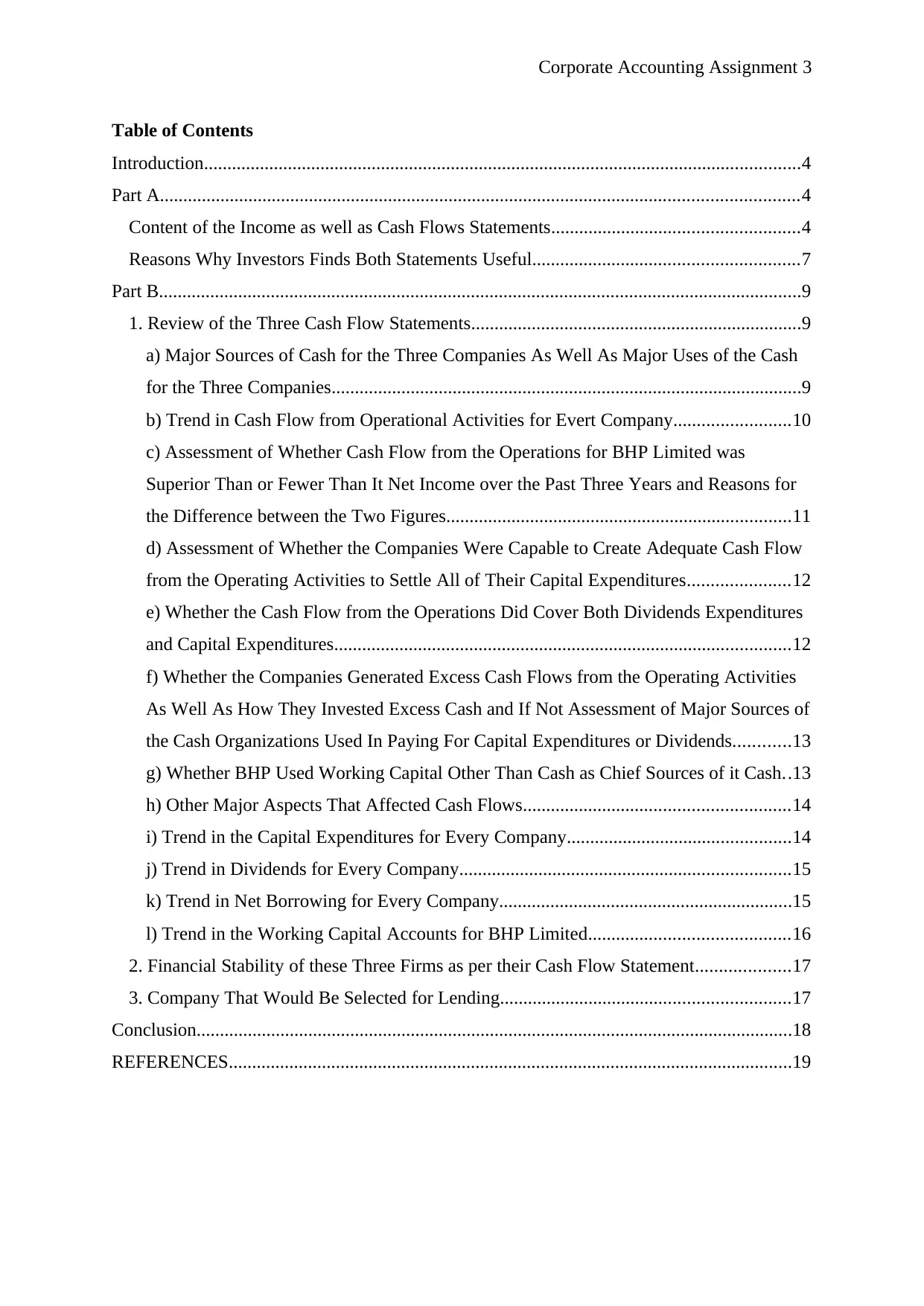
Corporate Accounting Assignment 3
Table of Contents
Introduction................................................................................................................................4
Part A.........................................................................................................................................4
Content of the Income as well as Cash Flows Statements.....................................................4
Reasons Why Investors Finds Both Statements Useful.........................................................7
Part B..........................................................................................................................................9
1. Review of the Three Cash Flow Statements.......................................................................9
a) Major Sources of Cash for the Three Companies As Well As Major Uses of the Cash
for the Three Companies.....................................................................................................9
b) Trend in Cash Flow from Operational Activities for Evert Company.........................10
c) Assessment of Whether Cash Flow from the Operations for BHP Limited was
Superior Than or Fewer Than It Net Income over the Past Three Years and Reasons for
the Difference between the Two Figures..........................................................................11
d) Assessment of Whether the Companies Were Capable to Create Adequate Cash Flow
from the Operating Activities to Settle All of Their Capital Expenditures......................12
e) Whether the Cash Flow from the Operations Did Cover Both Dividends Expenditures
and Capital Expenditures..................................................................................................12
f) Whether the Companies Generated Excess Cash Flows from the Operating Activities
As Well As How They Invested Excess Cash and If Not Assessment of Major Sources of
the Cash Organizations Used In Paying For Capital Expenditures or Dividends............13
g) Whether BHP Used Working Capital Other Than Cash as Chief Sources of it Cash..13
h) Other Major Aspects That Affected Cash Flows.........................................................14
i) Trend in the Capital Expenditures for Every Company................................................14
j) Trend in Dividends for Every Company.......................................................................15
k) Trend in Net Borrowing for Every Company...............................................................15
l) Trend in the Working Capital Accounts for BHP Limited...........................................16
2. Financial Stability of these Three Firms as per their Cash Flow Statement....................17
3. Company That Would Be Selected for Lending..............................................................17
Conclusion................................................................................................................................18
REFERENCES.........................................................................................................................19
Table of Contents
Introduction................................................................................................................................4
Part A.........................................................................................................................................4
Content of the Income as well as Cash Flows Statements.....................................................4
Reasons Why Investors Finds Both Statements Useful.........................................................7
Part B..........................................................................................................................................9
1. Review of the Three Cash Flow Statements.......................................................................9
a) Major Sources of Cash for the Three Companies As Well As Major Uses of the Cash
for the Three Companies.....................................................................................................9
b) Trend in Cash Flow from Operational Activities for Evert Company.........................10
c) Assessment of Whether Cash Flow from the Operations for BHP Limited was
Superior Than or Fewer Than It Net Income over the Past Three Years and Reasons for
the Difference between the Two Figures..........................................................................11
d) Assessment of Whether the Companies Were Capable to Create Adequate Cash Flow
from the Operating Activities to Settle All of Their Capital Expenditures......................12
e) Whether the Cash Flow from the Operations Did Cover Both Dividends Expenditures
and Capital Expenditures..................................................................................................12
f) Whether the Companies Generated Excess Cash Flows from the Operating Activities
As Well As How They Invested Excess Cash and If Not Assessment of Major Sources of
the Cash Organizations Used In Paying For Capital Expenditures or Dividends............13
g) Whether BHP Used Working Capital Other Than Cash as Chief Sources of it Cash..13
h) Other Major Aspects That Affected Cash Flows.........................................................14
i) Trend in the Capital Expenditures for Every Company................................................14
j) Trend in Dividends for Every Company.......................................................................15
k) Trend in Net Borrowing for Every Company...............................................................15
l) Trend in the Working Capital Accounts for BHP Limited...........................................16
2. Financial Stability of these Three Firms as per their Cash Flow Statement....................17
3. Company That Would Be Selected for Lending..............................................................17
Conclusion................................................................................................................................18
REFERENCES.........................................................................................................................19
⊘ This is a preview!⊘
Do you want full access?
Subscribe today to unlock all pages.

Trusted by 1+ million students worldwide
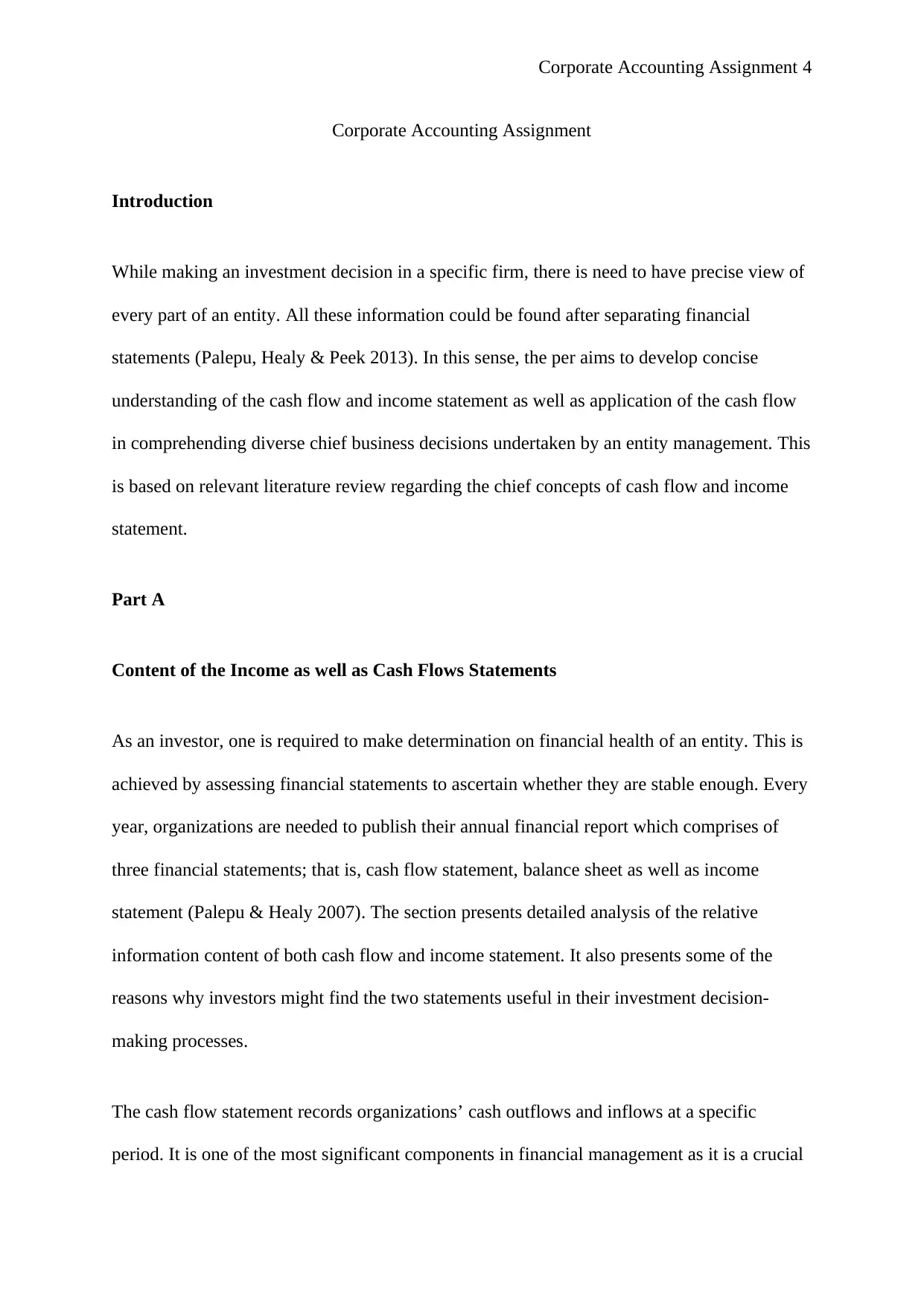
Corporate Accounting Assignment 4
Corporate Accounting Assignment
Introduction
While making an investment decision in a specific firm, there is need to have precise view of
every part of an entity. All these information could be found after separating financial
statements (Palepu, Healy & Peek 2013). In this sense, the per aims to develop concise
understanding of the cash flow and income statement as well as application of the cash flow
in comprehending diverse chief business decisions undertaken by an entity management. This
is based on relevant literature review regarding the chief concepts of cash flow and income
statement.
Part A
Content of the Income as well as Cash Flows Statements
As an investor, one is required to make determination on financial health of an entity. This is
achieved by assessing financial statements to ascertain whether they are stable enough. Every
year, organizations are needed to publish their annual financial report which comprises of
three financial statements; that is, cash flow statement, balance sheet as well as income
statement (Palepu & Healy 2007). The section presents detailed analysis of the relative
information content of both cash flow and income statement. It also presents some of the
reasons why investors might find the two statements useful in their investment decision-
making processes.
The cash flow statement records organizations’ cash outflows and inflows at a specific
period. It is one of the most significant components in financial management as it is a crucial
Corporate Accounting Assignment
Introduction
While making an investment decision in a specific firm, there is need to have precise view of
every part of an entity. All these information could be found after separating financial
statements (Palepu, Healy & Peek 2013). In this sense, the per aims to develop concise
understanding of the cash flow and income statement as well as application of the cash flow
in comprehending diverse chief business decisions undertaken by an entity management. This
is based on relevant literature review regarding the chief concepts of cash flow and income
statement.
Part A
Content of the Income as well as Cash Flows Statements
As an investor, one is required to make determination on financial health of an entity. This is
achieved by assessing financial statements to ascertain whether they are stable enough. Every
year, organizations are needed to publish their annual financial report which comprises of
three financial statements; that is, cash flow statement, balance sheet as well as income
statement (Palepu & Healy 2007). The section presents detailed analysis of the relative
information content of both cash flow and income statement. It also presents some of the
reasons why investors might find the two statements useful in their investment decision-
making processes.
The cash flow statement records organizations’ cash outflows and inflows at a specific
period. It is one of the most significant components in financial management as it is a crucial
Paraphrase This Document
Need a fresh take? Get an instant paraphrase of this document with our AI Paraphraser
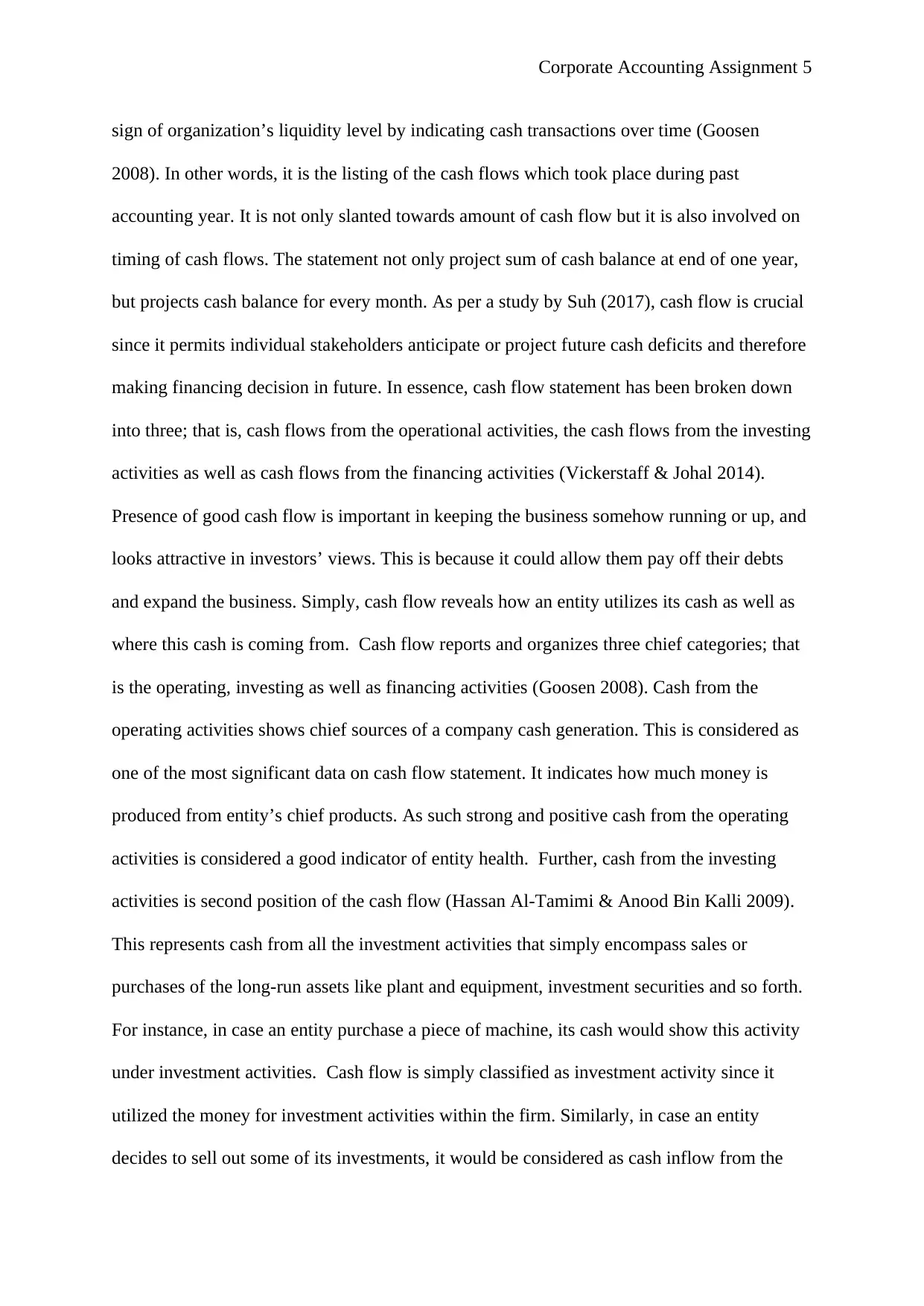
Corporate Accounting Assignment 5
sign of organization’s liquidity level by indicating cash transactions over time (Goosen
2008). In other words, it is the listing of the cash flows which took place during past
accounting year. It is not only slanted towards amount of cash flow but it is also involved on
timing of cash flows. The statement not only project sum of cash balance at end of one year,
but projects cash balance for every month. As per a study by Suh (2017), cash flow is crucial
since it permits individual stakeholders anticipate or project future cash deficits and therefore
making financing decision in future. In essence, cash flow statement has been broken down
into three; that is, cash flows from the operational activities, the cash flows from the investing
activities as well as cash flows from the financing activities (Vickerstaff & Johal 2014).
Presence of good cash flow is important in keeping the business somehow running or up, and
looks attractive in investors’ views. This is because it could allow them pay off their debts
and expand the business. Simply, cash flow reveals how an entity utilizes its cash as well as
where this cash is coming from. Cash flow reports and organizes three chief categories; that
is the operating, investing as well as financing activities (Goosen 2008). Cash from the
operating activities shows chief sources of a company cash generation. This is considered as
one of the most significant data on cash flow statement. It indicates how much money is
produced from entity’s chief products. As such strong and positive cash from the operating
activities is considered a good indicator of entity health. Further, cash from the investing
activities is second position of the cash flow (Hassan Al-Tamimi & Anood Bin Kalli 2009).
This represents cash from all the investment activities that simply encompass sales or
purchases of the long-run assets like plant and equipment, investment securities and so forth.
For instance, in case an entity purchase a piece of machine, its cash would show this activity
under investment activities. Cash flow is simply classified as investment activity since it
utilized the money for investment activities within the firm. Similarly, in case an entity
decides to sell out some of its investments, it would be considered as cash inflow from the
sign of organization’s liquidity level by indicating cash transactions over time (Goosen
2008). In other words, it is the listing of the cash flows which took place during past
accounting year. It is not only slanted towards amount of cash flow but it is also involved on
timing of cash flows. The statement not only project sum of cash balance at end of one year,
but projects cash balance for every month. As per a study by Suh (2017), cash flow is crucial
since it permits individual stakeholders anticipate or project future cash deficits and therefore
making financing decision in future. In essence, cash flow statement has been broken down
into three; that is, cash flows from the operational activities, the cash flows from the investing
activities as well as cash flows from the financing activities (Vickerstaff & Johal 2014).
Presence of good cash flow is important in keeping the business somehow running or up, and
looks attractive in investors’ views. This is because it could allow them pay off their debts
and expand the business. Simply, cash flow reveals how an entity utilizes its cash as well as
where this cash is coming from. Cash flow reports and organizes three chief categories; that
is the operating, investing as well as financing activities (Goosen 2008). Cash from the
operating activities shows chief sources of a company cash generation. This is considered as
one of the most significant data on cash flow statement. It indicates how much money is
produced from entity’s chief products. As such strong and positive cash from the operating
activities is considered a good indicator of entity health. Further, cash from the investing
activities is second position of the cash flow (Hassan Al-Tamimi & Anood Bin Kalli 2009).
This represents cash from all the investment activities that simply encompass sales or
purchases of the long-run assets like plant and equipment, investment securities and so forth.
For instance, in case an entity purchase a piece of machine, its cash would show this activity
under investment activities. Cash flow is simply classified as investment activity since it
utilized the money for investment activities within the firm. Similarly, in case an entity
decides to sell out some of its investments, it would be considered as cash inflow from the
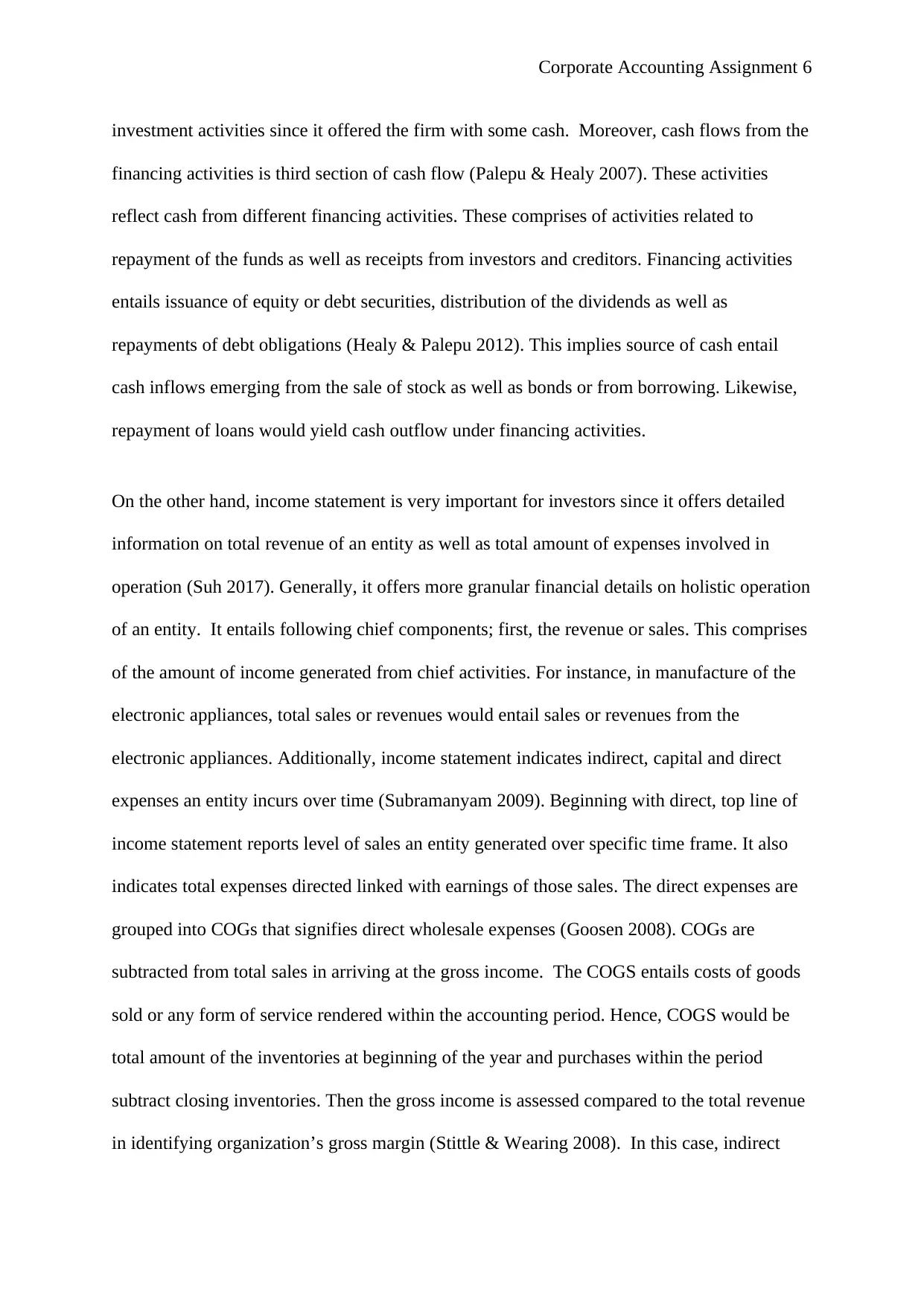
Corporate Accounting Assignment 6
investment activities since it offered the firm with some cash. Moreover, cash flows from the
financing activities is third section of cash flow (Palepu & Healy 2007). These activities
reflect cash from different financing activities. These comprises of activities related to
repayment of the funds as well as receipts from investors and creditors. Financing activities
entails issuance of equity or debt securities, distribution of the dividends as well as
repayments of debt obligations (Healy & Palepu 2012). This implies source of cash entail
cash inflows emerging from the sale of stock as well as bonds or from borrowing. Likewise,
repayment of loans would yield cash outflow under financing activities.
On the other hand, income statement is very important for investors since it offers detailed
information on total revenue of an entity as well as total amount of expenses involved in
operation (Suh 2017). Generally, it offers more granular financial details on holistic operation
of an entity. It entails following chief components; first, the revenue or sales. This comprises
of the amount of income generated from chief activities. For instance, in manufacture of the
electronic appliances, total sales or revenues would entail sales or revenues from the
electronic appliances. Additionally, income statement indicates indirect, capital and direct
expenses an entity incurs over time (Subramanyam 2009). Beginning with direct, top line of
income statement reports level of sales an entity generated over specific time frame. It also
indicates total expenses directed linked with earnings of those sales. The direct expenses are
grouped into COGs that signifies direct wholesale expenses (Goosen 2008). COGs are
subtracted from total sales in arriving at the gross income. The COGS entails costs of goods
sold or any form of service rendered within the accounting period. Hence, COGS would be
total amount of the inventories at beginning of the year and purchases within the period
subtract closing inventories. Then the gross income is assessed compared to the total revenue
in identifying organization’s gross margin (Stittle & Wearing 2008). In this case, indirect
investment activities since it offered the firm with some cash. Moreover, cash flows from the
financing activities is third section of cash flow (Palepu & Healy 2007). These activities
reflect cash from different financing activities. These comprises of activities related to
repayment of the funds as well as receipts from investors and creditors. Financing activities
entails issuance of equity or debt securities, distribution of the dividends as well as
repayments of debt obligations (Healy & Palepu 2012). This implies source of cash entail
cash inflows emerging from the sale of stock as well as bonds or from borrowing. Likewise,
repayment of loans would yield cash outflow under financing activities.
On the other hand, income statement is very important for investors since it offers detailed
information on total revenue of an entity as well as total amount of expenses involved in
operation (Suh 2017). Generally, it offers more granular financial details on holistic operation
of an entity. It entails following chief components; first, the revenue or sales. This comprises
of the amount of income generated from chief activities. For instance, in manufacture of the
electronic appliances, total sales or revenues would entail sales or revenues from the
electronic appliances. Additionally, income statement indicates indirect, capital and direct
expenses an entity incurs over time (Subramanyam 2009). Beginning with direct, top line of
income statement reports level of sales an entity generated over specific time frame. It also
indicates total expenses directed linked with earnings of those sales. The direct expenses are
grouped into COGs that signifies direct wholesale expenses (Goosen 2008). COGs are
subtracted from total sales in arriving at the gross income. The COGS entails costs of goods
sold or any form of service rendered within the accounting period. Hence, COGS would be
total amount of the inventories at beginning of the year and purchases within the period
subtract closing inventories. Then the gross income is assessed compared to the total revenue
in identifying organization’s gross margin (Stittle & Wearing 2008). In this case, indirect
⊘ This is a preview!⊘
Do you want full access?
Subscribe today to unlock all pages.

Trusted by 1+ million students worldwide
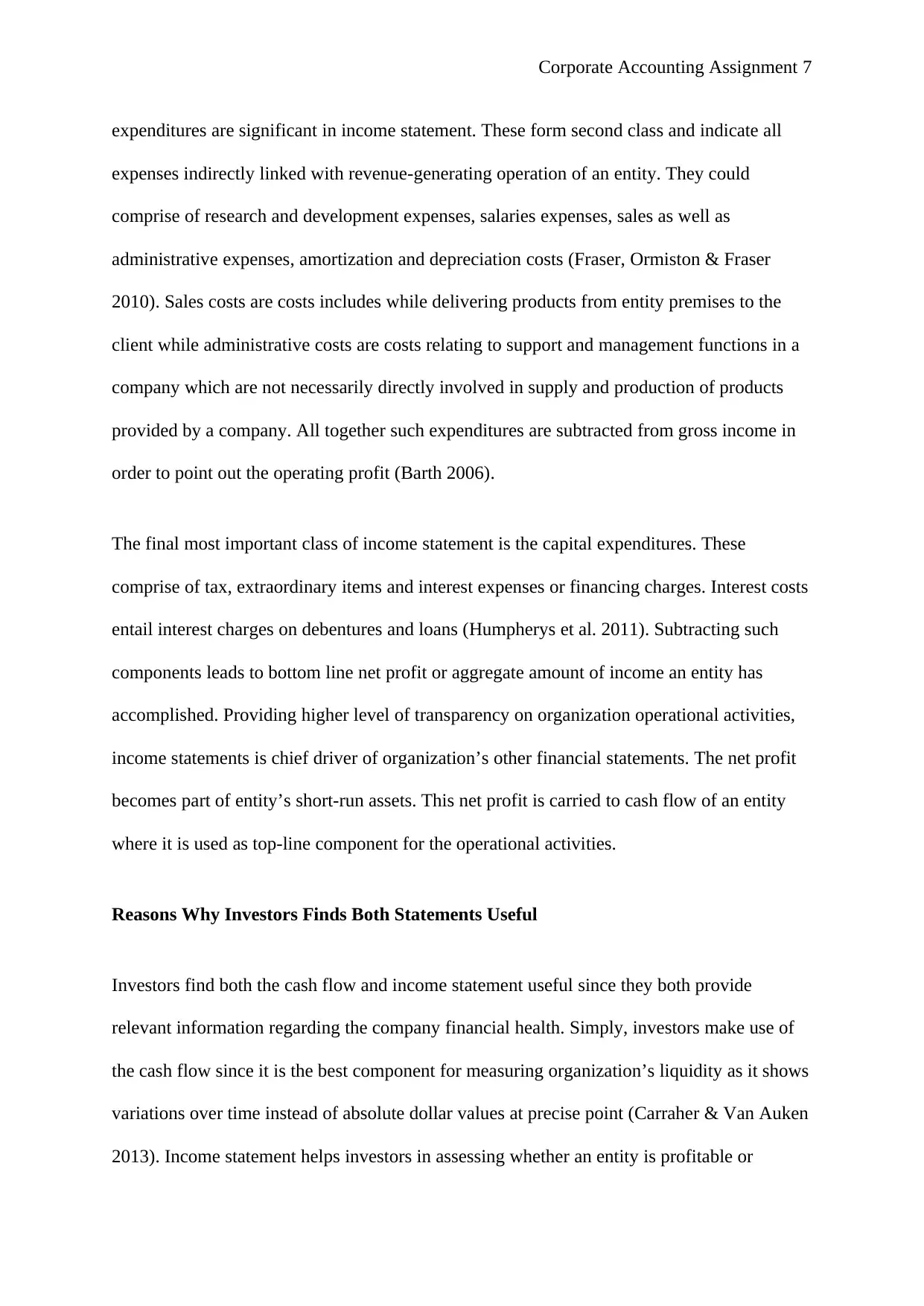
Corporate Accounting Assignment 7
expenditures are significant in income statement. These form second class and indicate all
expenses indirectly linked with revenue-generating operation of an entity. They could
comprise of research and development expenses, salaries expenses, sales as well as
administrative expenses, amortization and depreciation costs (Fraser, Ormiston & Fraser
2010). Sales costs are costs includes while delivering products from entity premises to the
client while administrative costs are costs relating to support and management functions in a
company which are not necessarily directly involved in supply and production of products
provided by a company. All together such expenditures are subtracted from gross income in
order to point out the operating profit (Barth 2006).
The final most important class of income statement is the capital expenditures. These
comprise of tax, extraordinary items and interest expenses or financing charges. Interest costs
entail interest charges on debentures and loans (Humpherys et al. 2011). Subtracting such
components leads to bottom line net profit or aggregate amount of income an entity has
accomplished. Providing higher level of transparency on organization operational activities,
income statements is chief driver of organization’s other financial statements. The net profit
becomes part of entity’s short-run assets. This net profit is carried to cash flow of an entity
where it is used as top-line component for the operational activities.
Reasons Why Investors Finds Both Statements Useful
Investors find both the cash flow and income statement useful since they both provide
relevant information regarding the company financial health. Simply, investors make use of
the cash flow since it is the best component for measuring organization’s liquidity as it shows
variations over time instead of absolute dollar values at precise point (Carraher & Van Auken
2013). Income statement helps investors in assessing whether an entity is profitable or
expenditures are significant in income statement. These form second class and indicate all
expenses indirectly linked with revenue-generating operation of an entity. They could
comprise of research and development expenses, salaries expenses, sales as well as
administrative expenses, amortization and depreciation costs (Fraser, Ormiston & Fraser
2010). Sales costs are costs includes while delivering products from entity premises to the
client while administrative costs are costs relating to support and management functions in a
company which are not necessarily directly involved in supply and production of products
provided by a company. All together such expenditures are subtracted from gross income in
order to point out the operating profit (Barth 2006).
The final most important class of income statement is the capital expenditures. These
comprise of tax, extraordinary items and interest expenses or financing charges. Interest costs
entail interest charges on debentures and loans (Humpherys et al. 2011). Subtracting such
components leads to bottom line net profit or aggregate amount of income an entity has
accomplished. Providing higher level of transparency on organization operational activities,
income statements is chief driver of organization’s other financial statements. The net profit
becomes part of entity’s short-run assets. This net profit is carried to cash flow of an entity
where it is used as top-line component for the operational activities.
Reasons Why Investors Finds Both Statements Useful
Investors find both the cash flow and income statement useful since they both provide
relevant information regarding the company financial health. Simply, investors make use of
the cash flow since it is the best component for measuring organization’s liquidity as it shows
variations over time instead of absolute dollar values at precise point (Carraher & Van Auken
2013). Income statement helps investors in assessing whether an entity is profitable or
Paraphrase This Document
Need a fresh take? Get an instant paraphrase of this document with our AI Paraphraser
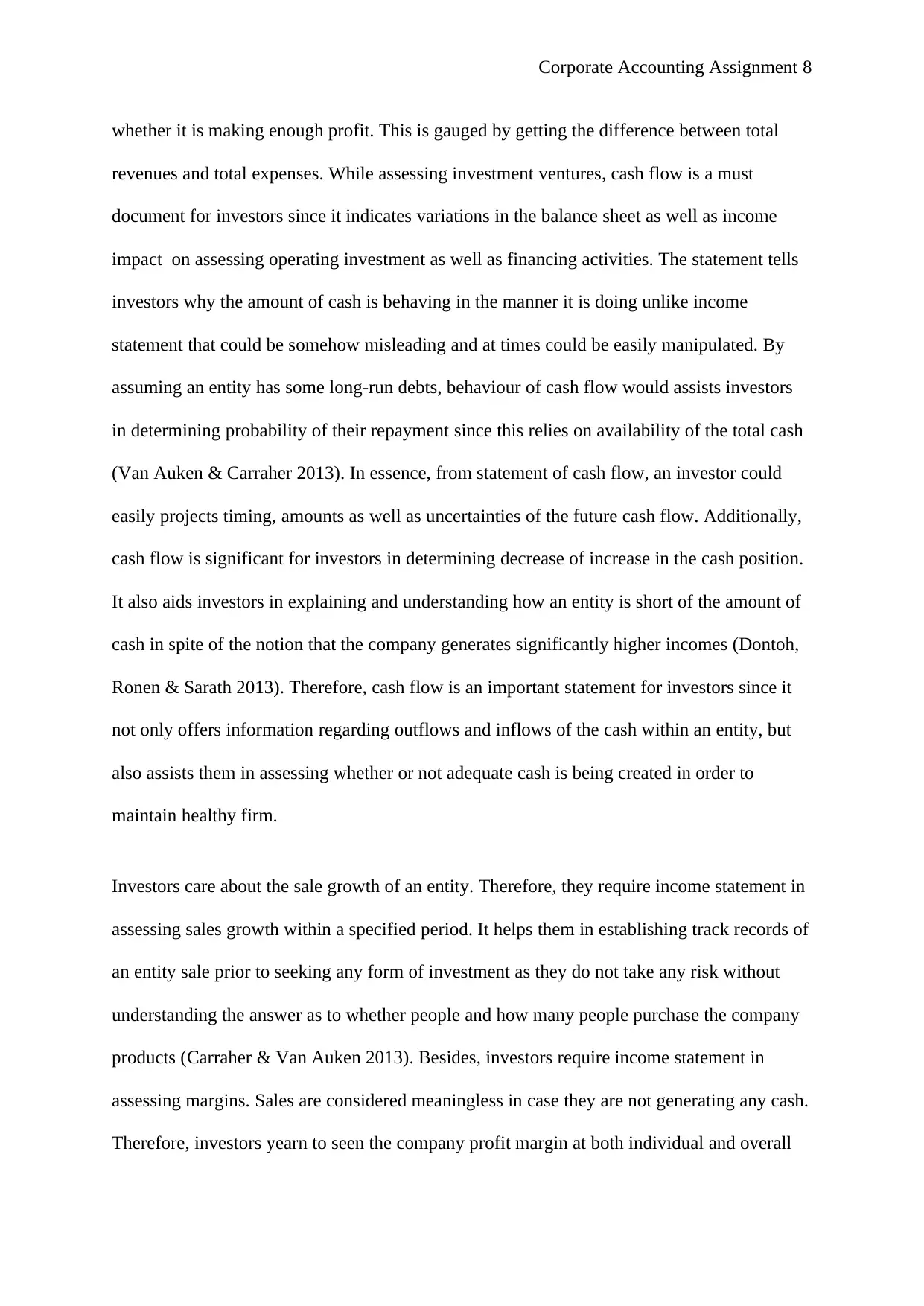
Corporate Accounting Assignment 8
whether it is making enough profit. This is gauged by getting the difference between total
revenues and total expenses. While assessing investment ventures, cash flow is a must
document for investors since it indicates variations in the balance sheet as well as income
impact on assessing operating investment as well as financing activities. The statement tells
investors why the amount of cash is behaving in the manner it is doing unlike income
statement that could be somehow misleading and at times could be easily manipulated. By
assuming an entity has some long-run debts, behaviour of cash flow would assists investors
in determining probability of their repayment since this relies on availability of the total cash
(Van Auken & Carraher 2013). In essence, from statement of cash flow, an investor could
easily projects timing, amounts as well as uncertainties of the future cash flow. Additionally,
cash flow is significant for investors in determining decrease of increase in the cash position.
It also aids investors in explaining and understanding how an entity is short of the amount of
cash in spite of the notion that the company generates significantly higher incomes (Dontoh,
Ronen & Sarath 2013). Therefore, cash flow is an important statement for investors since it
not only offers information regarding outflows and inflows of the cash within an entity, but
also assists them in assessing whether or not adequate cash is being created in order to
maintain healthy firm.
Investors care about the sale growth of an entity. Therefore, they require income statement in
assessing sales growth within a specified period. It helps them in establishing track records of
an entity sale prior to seeking any form of investment as they do not take any risk without
understanding the answer as to whether people and how many people purchase the company
products (Carraher & Van Auken 2013). Besides, investors require income statement in
assessing margins. Sales are considered meaningless in case they are not generating any cash.
Therefore, investors yearn to seen the company profit margin at both individual and overall
whether it is making enough profit. This is gauged by getting the difference between total
revenues and total expenses. While assessing investment ventures, cash flow is a must
document for investors since it indicates variations in the balance sheet as well as income
impact on assessing operating investment as well as financing activities. The statement tells
investors why the amount of cash is behaving in the manner it is doing unlike income
statement that could be somehow misleading and at times could be easily manipulated. By
assuming an entity has some long-run debts, behaviour of cash flow would assists investors
in determining probability of their repayment since this relies on availability of the total cash
(Van Auken & Carraher 2013). In essence, from statement of cash flow, an investor could
easily projects timing, amounts as well as uncertainties of the future cash flow. Additionally,
cash flow is significant for investors in determining decrease of increase in the cash position.
It also aids investors in explaining and understanding how an entity is short of the amount of
cash in spite of the notion that the company generates significantly higher incomes (Dontoh,
Ronen & Sarath 2013). Therefore, cash flow is an important statement for investors since it
not only offers information regarding outflows and inflows of the cash within an entity, but
also assists them in assessing whether or not adequate cash is being created in order to
maintain healthy firm.
Investors care about the sale growth of an entity. Therefore, they require income statement in
assessing sales growth within a specified period. It helps them in establishing track records of
an entity sale prior to seeking any form of investment as they do not take any risk without
understanding the answer as to whether people and how many people purchase the company
products (Carraher & Van Auken 2013). Besides, investors require income statement in
assessing margins. Sales are considered meaningless in case they are not generating any cash.
Therefore, investors yearn to seen the company profit margin at both individual and overall
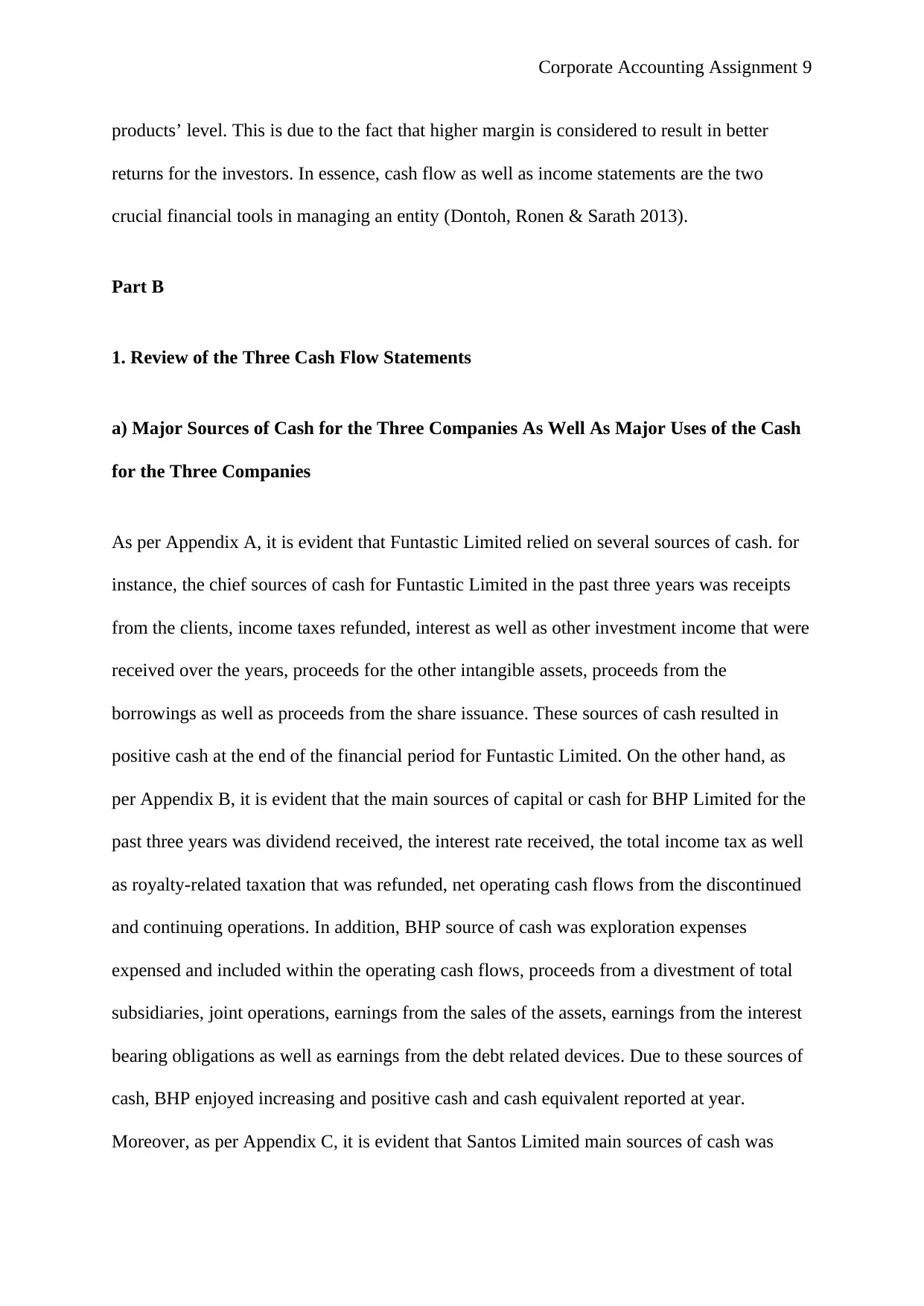
Corporate Accounting Assignment 9
products’ level. This is due to the fact that higher margin is considered to result in better
returns for the investors. In essence, cash flow as well as income statements are the two
crucial financial tools in managing an entity (Dontoh, Ronen & Sarath 2013).
Part B
1. Review of the Three Cash Flow Statements
a) Major Sources of Cash for the Three Companies As Well As Major Uses of the Cash
for the Three Companies
As per Appendix A, it is evident that Funtastic Limited relied on several sources of cash. for
instance, the chief sources of cash for Funtastic Limited in the past three years was receipts
from the clients, income taxes refunded, interest as well as other investment income that were
received over the years, proceeds for the other intangible assets, proceeds from the
borrowings as well as proceeds from the share issuance. These sources of cash resulted in
positive cash at the end of the financial period for Funtastic Limited. On the other hand, as
per Appendix B, it is evident that the main sources of capital or cash for BHP Limited for the
past three years was dividend received, the interest rate received, the total income tax as well
as royalty-related taxation that was refunded, net operating cash flows from the discontinued
and continuing operations. In addition, BHP source of cash was exploration expenses
expensed and included within the operating cash flows, proceeds from a divestment of total
subsidiaries, joint operations, earnings from the sales of the assets, earnings from the interest
bearing obligations as well as earnings from the debt related devices. Due to these sources of
cash, BHP enjoyed increasing and positive cash and cash equivalent reported at year.
Moreover, as per Appendix C, it is evident that Santos Limited main sources of cash was
products’ level. This is due to the fact that higher margin is considered to result in better
returns for the investors. In essence, cash flow as well as income statements are the two
crucial financial tools in managing an entity (Dontoh, Ronen & Sarath 2013).
Part B
1. Review of the Three Cash Flow Statements
a) Major Sources of Cash for the Three Companies As Well As Major Uses of the Cash
for the Three Companies
As per Appendix A, it is evident that Funtastic Limited relied on several sources of cash. for
instance, the chief sources of cash for Funtastic Limited in the past three years was receipts
from the clients, income taxes refunded, interest as well as other investment income that were
received over the years, proceeds for the other intangible assets, proceeds from the
borrowings as well as proceeds from the share issuance. These sources of cash resulted in
positive cash at the end of the financial period for Funtastic Limited. On the other hand, as
per Appendix B, it is evident that the main sources of capital or cash for BHP Limited for the
past three years was dividend received, the interest rate received, the total income tax as well
as royalty-related taxation that was refunded, net operating cash flows from the discontinued
and continuing operations. In addition, BHP source of cash was exploration expenses
expensed and included within the operating cash flows, proceeds from a divestment of total
subsidiaries, joint operations, earnings from the sales of the assets, earnings from the interest
bearing obligations as well as earnings from the debt related devices. Due to these sources of
cash, BHP enjoyed increasing and positive cash and cash equivalent reported at year.
Moreover, as per Appendix C, it is evident that Santos Limited main sources of cash was
⊘ This is a preview!⊘
Do you want full access?
Subscribe today to unlock all pages.

Trusted by 1+ million students worldwide
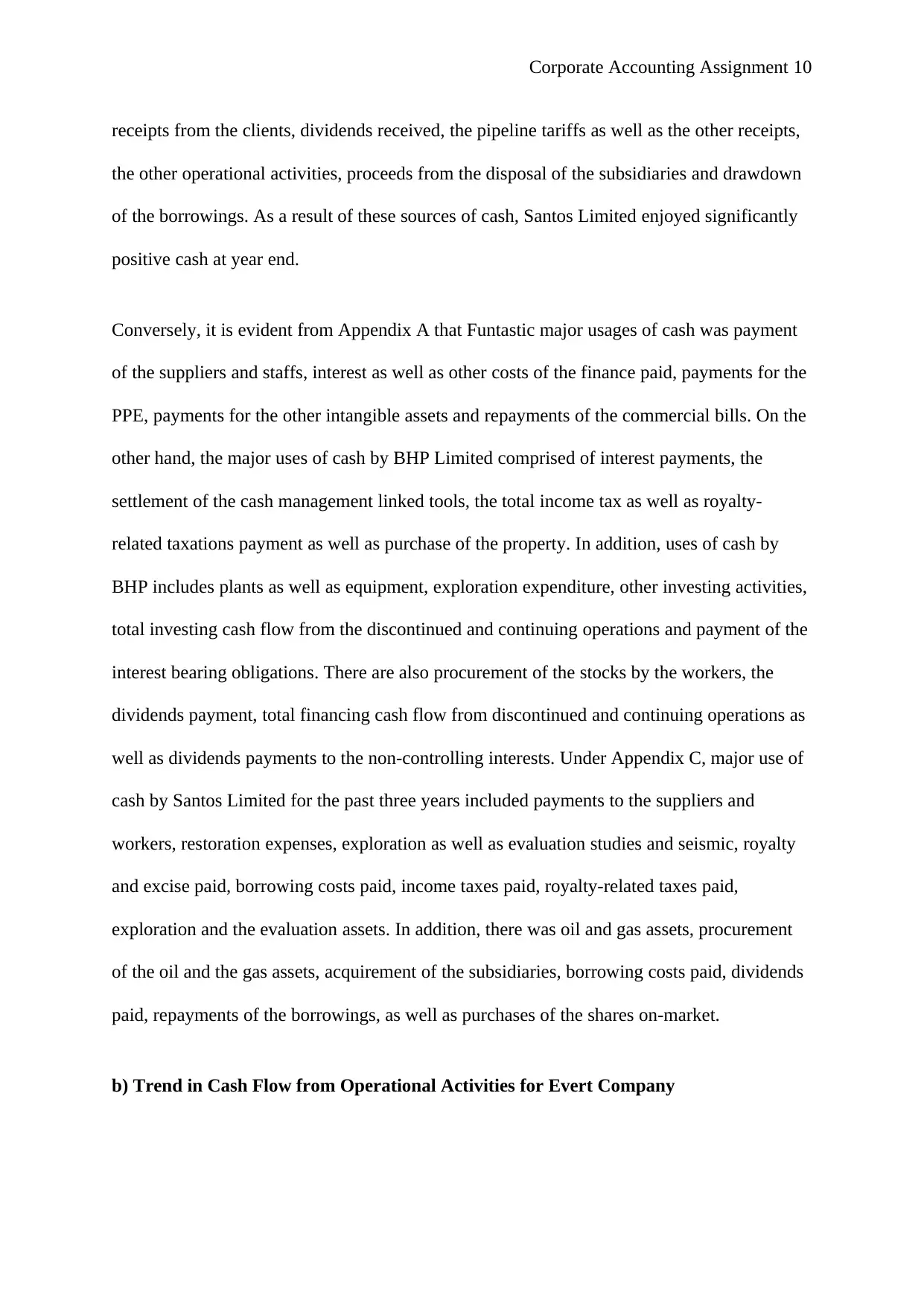
Corporate Accounting Assignment 10
receipts from the clients, dividends received, the pipeline tariffs as well as the other receipts,
the other operational activities, proceeds from the disposal of the subsidiaries and drawdown
of the borrowings. As a result of these sources of cash, Santos Limited enjoyed significantly
positive cash at year end.
Conversely, it is evident from Appendix A that Funtastic major usages of cash was payment
of the suppliers and staffs, interest as well as other costs of the finance paid, payments for the
PPE, payments for the other intangible assets and repayments of the commercial bills. On the
other hand, the major uses of cash by BHP Limited comprised of interest payments, the
settlement of the cash management linked tools, the total income tax as well as royalty-
related taxations payment as well as purchase of the property. In addition, uses of cash by
BHP includes plants as well as equipment, exploration expenditure, other investing activities,
total investing cash flow from the discontinued and continuing operations and payment of the
interest bearing obligations. There are also procurement of the stocks by the workers, the
dividends payment, total financing cash flow from discontinued and continuing operations as
well as dividends payments to the non-controlling interests. Under Appendix C, major use of
cash by Santos Limited for the past three years included payments to the suppliers and
workers, restoration expenses, exploration as well as evaluation studies and seismic, royalty
and excise paid, borrowing costs paid, income taxes paid, royalty-related taxes paid,
exploration and the evaluation assets. In addition, there was oil and gas assets, procurement
of the oil and the gas assets, acquirement of the subsidiaries, borrowing costs paid, dividends
paid, repayments of the borrowings, as well as purchases of the shares on-market.
b) Trend in Cash Flow from Operational Activities for Evert Company
receipts from the clients, dividends received, the pipeline tariffs as well as the other receipts,
the other operational activities, proceeds from the disposal of the subsidiaries and drawdown
of the borrowings. As a result of these sources of cash, Santos Limited enjoyed significantly
positive cash at year end.
Conversely, it is evident from Appendix A that Funtastic major usages of cash was payment
of the suppliers and staffs, interest as well as other costs of the finance paid, payments for the
PPE, payments for the other intangible assets and repayments of the commercial bills. On the
other hand, the major uses of cash by BHP Limited comprised of interest payments, the
settlement of the cash management linked tools, the total income tax as well as royalty-
related taxations payment as well as purchase of the property. In addition, uses of cash by
BHP includes plants as well as equipment, exploration expenditure, other investing activities,
total investing cash flow from the discontinued and continuing operations and payment of the
interest bearing obligations. There are also procurement of the stocks by the workers, the
dividends payment, total financing cash flow from discontinued and continuing operations as
well as dividends payments to the non-controlling interests. Under Appendix C, major use of
cash by Santos Limited for the past three years included payments to the suppliers and
workers, restoration expenses, exploration as well as evaluation studies and seismic, royalty
and excise paid, borrowing costs paid, income taxes paid, royalty-related taxes paid,
exploration and the evaluation assets. In addition, there was oil and gas assets, procurement
of the oil and the gas assets, acquirement of the subsidiaries, borrowing costs paid, dividends
paid, repayments of the borrowings, as well as purchases of the shares on-market.
b) Trend in Cash Flow from Operational Activities for Evert Company
Paraphrase This Document
Need a fresh take? Get an instant paraphrase of this document with our AI Paraphraser
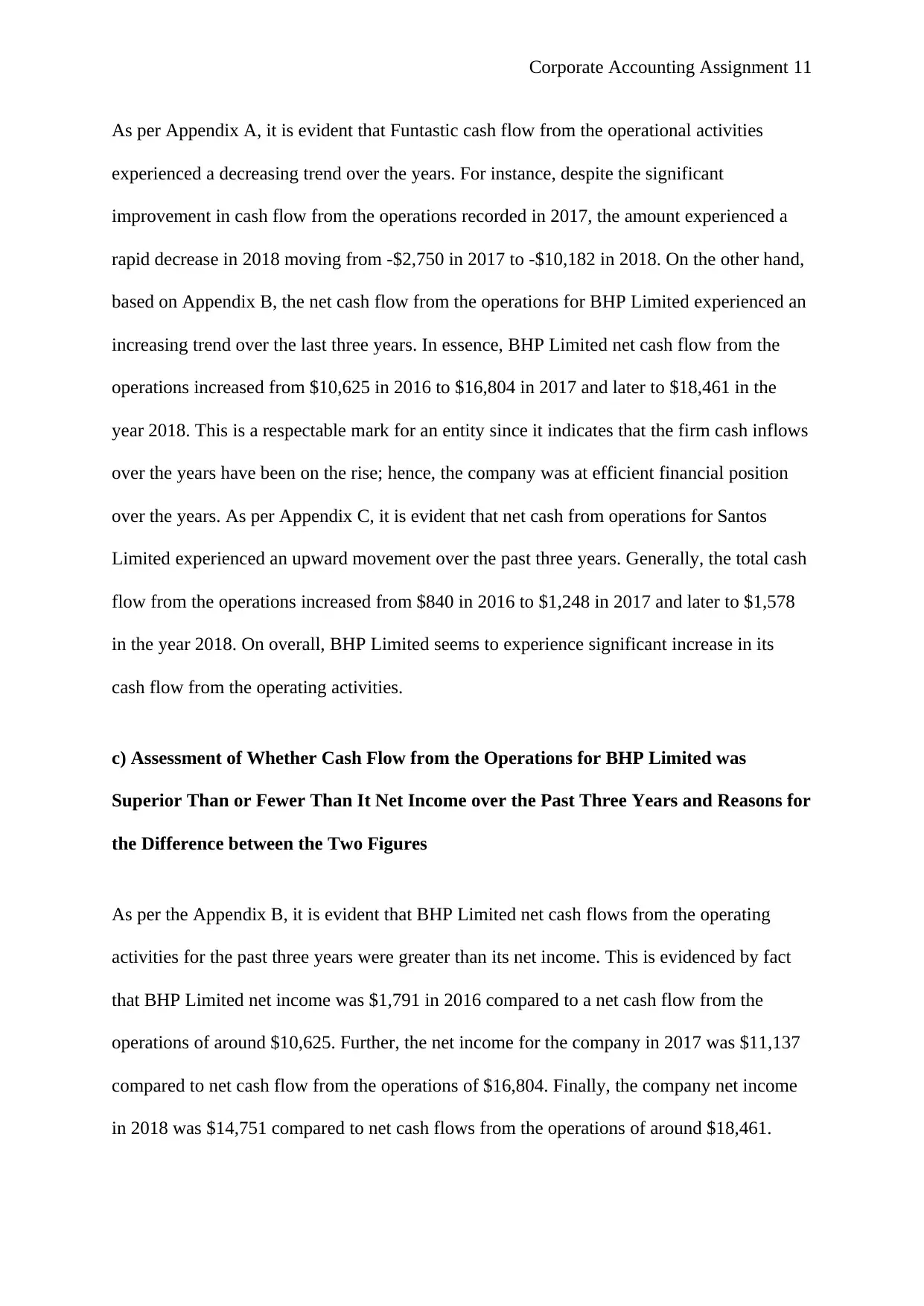
Corporate Accounting Assignment 11
As per Appendix A, it is evident that Funtastic cash flow from the operational activities
experienced a decreasing trend over the years. For instance, despite the significant
improvement in cash flow from the operations recorded in 2017, the amount experienced a
rapid decrease in 2018 moving from -$2,750 in 2017 to -$10,182 in 2018. On the other hand,
based on Appendix B, the net cash flow from the operations for BHP Limited experienced an
increasing trend over the last three years. In essence, BHP Limited net cash flow from the
operations increased from $10,625 in 2016 to $16,804 in 2017 and later to $18,461 in the
year 2018. This is a respectable mark for an entity since it indicates that the firm cash inflows
over the years have been on the rise; hence, the company was at efficient financial position
over the years. As per Appendix C, it is evident that net cash from operations for Santos
Limited experienced an upward movement over the past three years. Generally, the total cash
flow from the operations increased from $840 in 2016 to $1,248 in 2017 and later to $1,578
in the year 2018. On overall, BHP Limited seems to experience significant increase in its
cash flow from the operating activities.
c) Assessment of Whether Cash Flow from the Operations for BHP Limited was
Superior Than or Fewer Than It Net Income over the Past Three Years and Reasons for
the Difference between the Two Figures
As per the Appendix B, it is evident that BHP Limited net cash flows from the operating
activities for the past three years were greater than its net income. This is evidenced by fact
that BHP Limited net income was $1,791 in 2016 compared to a net cash flow from the
operations of around $10,625. Further, the net income for the company in 2017 was $11,137
compared to net cash flow from the operations of $16,804. Finally, the company net income
in 2018 was $14,751 compared to net cash flows from the operations of around $18,461.
As per Appendix A, it is evident that Funtastic cash flow from the operational activities
experienced a decreasing trend over the years. For instance, despite the significant
improvement in cash flow from the operations recorded in 2017, the amount experienced a
rapid decrease in 2018 moving from -$2,750 in 2017 to -$10,182 in 2018. On the other hand,
based on Appendix B, the net cash flow from the operations for BHP Limited experienced an
increasing trend over the last three years. In essence, BHP Limited net cash flow from the
operations increased from $10,625 in 2016 to $16,804 in 2017 and later to $18,461 in the
year 2018. This is a respectable mark for an entity since it indicates that the firm cash inflows
over the years have been on the rise; hence, the company was at efficient financial position
over the years. As per Appendix C, it is evident that net cash from operations for Santos
Limited experienced an upward movement over the past three years. Generally, the total cash
flow from the operations increased from $840 in 2016 to $1,248 in 2017 and later to $1,578
in the year 2018. On overall, BHP Limited seems to experience significant increase in its
cash flow from the operating activities.
c) Assessment of Whether Cash Flow from the Operations for BHP Limited was
Superior Than or Fewer Than It Net Income over the Past Three Years and Reasons for
the Difference between the Two Figures
As per the Appendix B, it is evident that BHP Limited net cash flows from the operating
activities for the past three years were greater than its net income. This is evidenced by fact
that BHP Limited net income was $1,791 in 2016 compared to a net cash flow from the
operations of around $10,625. Further, the net income for the company in 2017 was $11,137
compared to net cash flow from the operations of $16,804. Finally, the company net income
in 2018 was $14,751 compared to net cash flows from the operations of around $18,461.
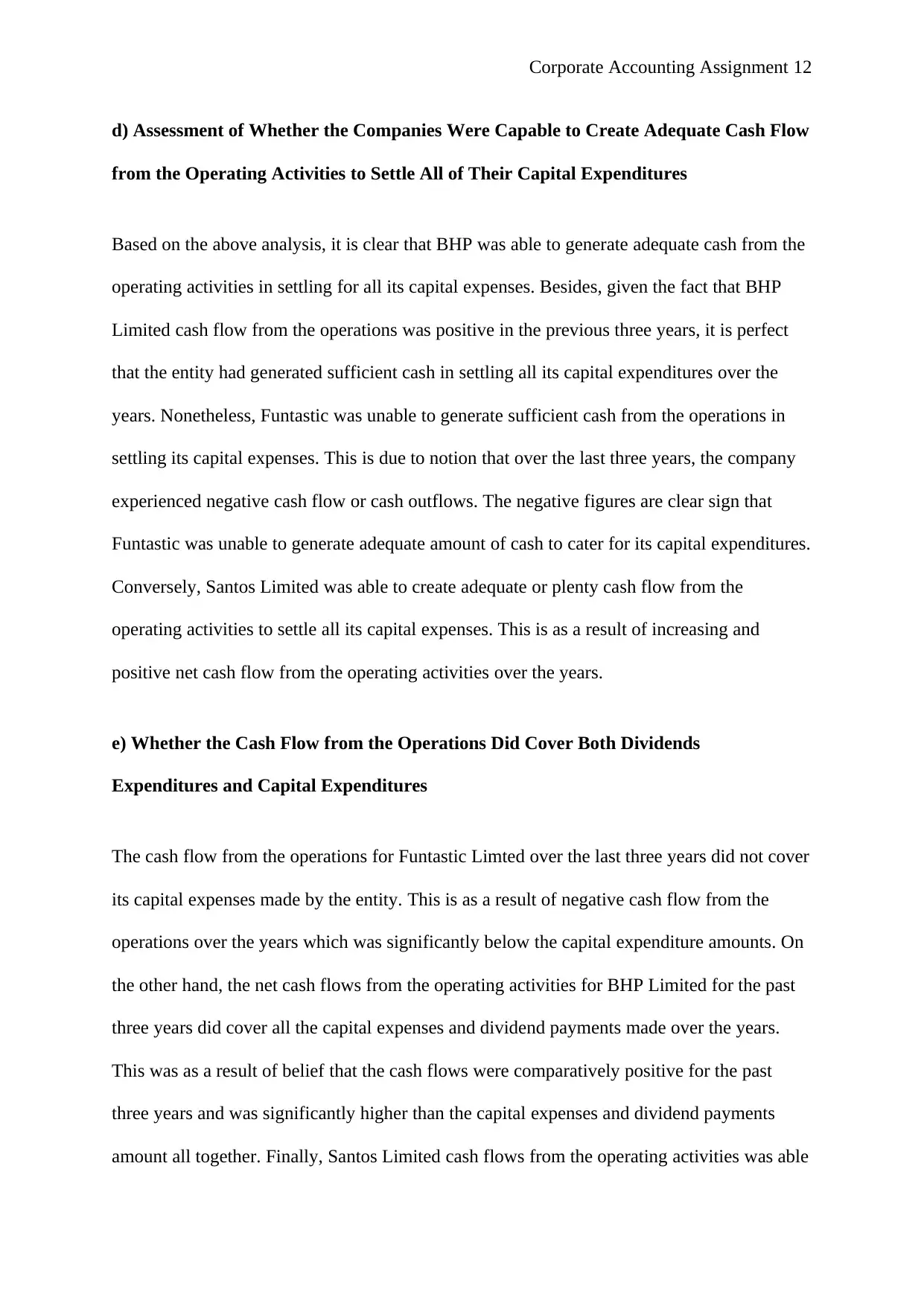
Corporate Accounting Assignment 12
d) Assessment of Whether the Companies Were Capable to Create Adequate Cash Flow
from the Operating Activities to Settle All of Their Capital Expenditures
Based on the above analysis, it is clear that BHP was able to generate adequate cash from the
operating activities in settling for all its capital expenses. Besides, given the fact that BHP
Limited cash flow from the operations was positive in the previous three years, it is perfect
that the entity had generated sufficient cash in settling all its capital expenditures over the
years. Nonetheless, Funtastic was unable to generate sufficient cash from the operations in
settling its capital expenses. This is due to notion that over the last three years, the company
experienced negative cash flow or cash outflows. The negative figures are clear sign that
Funtastic was unable to generate adequate amount of cash to cater for its capital expenditures.
Conversely, Santos Limited was able to create adequate or plenty cash flow from the
operating activities to settle all its capital expenses. This is as a result of increasing and
positive net cash flow from the operating activities over the years.
e) Whether the Cash Flow from the Operations Did Cover Both Dividends
Expenditures and Capital Expenditures
The cash flow from the operations for Funtastic Limted over the last three years did not cover
its capital expenses made by the entity. This is as a result of negative cash flow from the
operations over the years which was significantly below the capital expenditure amounts. On
the other hand, the net cash flows from the operating activities for BHP Limited for the past
three years did cover all the capital expenses and dividend payments made over the years.
This was as a result of belief that the cash flows were comparatively positive for the past
three years and was significantly higher than the capital expenses and dividend payments
amount all together. Finally, Santos Limited cash flows from the operating activities was able
d) Assessment of Whether the Companies Were Capable to Create Adequate Cash Flow
from the Operating Activities to Settle All of Their Capital Expenditures
Based on the above analysis, it is clear that BHP was able to generate adequate cash from the
operating activities in settling for all its capital expenses. Besides, given the fact that BHP
Limited cash flow from the operations was positive in the previous three years, it is perfect
that the entity had generated sufficient cash in settling all its capital expenditures over the
years. Nonetheless, Funtastic was unable to generate sufficient cash from the operations in
settling its capital expenses. This is due to notion that over the last three years, the company
experienced negative cash flow or cash outflows. The negative figures are clear sign that
Funtastic was unable to generate adequate amount of cash to cater for its capital expenditures.
Conversely, Santos Limited was able to create adequate or plenty cash flow from the
operating activities to settle all its capital expenses. This is as a result of increasing and
positive net cash flow from the operating activities over the years.
e) Whether the Cash Flow from the Operations Did Cover Both Dividends
Expenditures and Capital Expenditures
The cash flow from the operations for Funtastic Limted over the last three years did not cover
its capital expenses made by the entity. This is as a result of negative cash flow from the
operations over the years which was significantly below the capital expenditure amounts. On
the other hand, the net cash flows from the operating activities for BHP Limited for the past
three years did cover all the capital expenses and dividend payments made over the years.
This was as a result of belief that the cash flows were comparatively positive for the past
three years and was significantly higher than the capital expenses and dividend payments
amount all together. Finally, Santos Limited cash flows from the operating activities was able
⊘ This is a preview!⊘
Do you want full access?
Subscribe today to unlock all pages.

Trusted by 1+ million students worldwide
1 out of 20
Related Documents
Your All-in-One AI-Powered Toolkit for Academic Success.
+13062052269
info@desklib.com
Available 24*7 on WhatsApp / Email
![[object Object]](/_next/static/media/star-bottom.7253800d.svg)
Unlock your academic potential
Copyright © 2020–2025 A2Z Services. All Rights Reserved. Developed and managed by ZUCOL.



